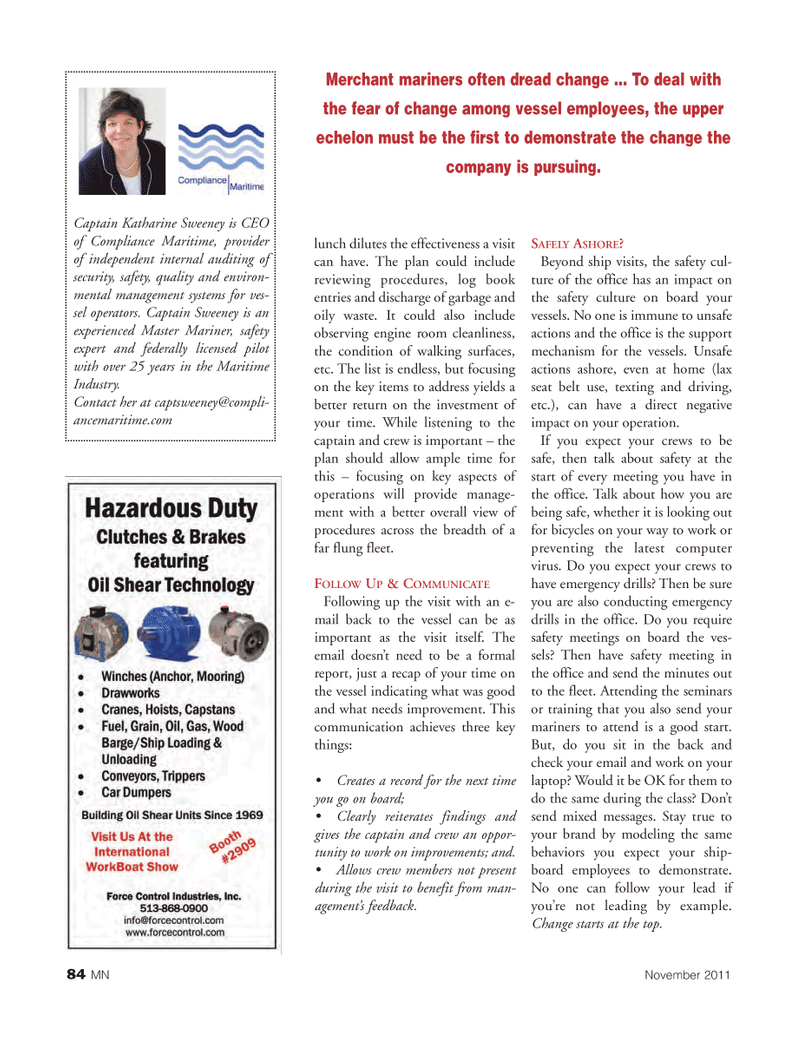
Page 84: of Marine News Magazine (November 2011)
Workboat Annual
Read this page in Pdf, Flash or Html5 edition of November 2011 Marine News Magazine
84MNNovember 2011lunch dilutes the effectiveness a visit can have. The plan could include reviewing procedures, log book entries and discharge of garbage andoily waste. It could also include observing engine room cleanliness, the condition of walking surfaces, etc. The list is endless, but focusing on the key items to address yields a better return on the investment of your time. While listening to the captain and crew is important ? the plan should allow ample time for this ? focusing on key aspects ofoperations will provide manage- ment with a better overall view of procedures across the breadth of a far flung fleet.FOLLOW UP& COMMUNICATE Following up the visit with an e- mail back to the vessel can be as important as the visit itself. The email doesn?t need to be a formal report, just a recap of your time on the vessel indicating what was good and what needs improvement. This communication achieves three key things:Creates a record for the next time you go on board; Clearly reiterates findings and gives the captain and crew an oppor- tunity to work on improvements; and. Allows crew members not present during the visit to benefit from man- agement?s feedback. SAFELY ASHORE?Beyond ship visits, the safety cul- ture of the office has an impact onthe safety culture on board your vessels. No one is immune to unsafe actions and the office is the support mechanism for the vessels. Unsafe actions ashore, even at home (lax seat belt use, texting and driving,etc.), can have a direct negative impact on your operation. If you expect your crews to be safe, then talk about safety at thestart of every meeting you have in the office. Talk about how you are being safe, whether it is looking outfor bicycles on your way to work or preventing the latest computer virus. Do you expect your crews to have emergency drills? Then be sure you are also conducting emergency drills in the office. Do you require safety meetings on board the ves- sels? Then have safety meeting in the office and send the minutes outto the fleet. Attending the seminars or training that you also send your mariners to attend is a good start. But, do you sit in the back and check your email and work on your laptop? Would it be OK for them to do the same during the class? Don?t send mixed messages. Stay true to your brand by modeling the same behaviors you expect your ship- board employees to demonstrate. No one can follow your lead if you?re not leading by example. Change starts at the top. Captain Katharine Sweeney is CEO of Compliance Maritime, provider of independent internal auditing of security, safety, quality and environ- mental management systems for ves- sel operators. Captain Sweeney is an experienced Master Mariner, safety expert and federally licensed pilot with over 25 years in the Maritime Industry. Contact her at captsweeney@compli- ancemaritime.comMerchant mariners often dread change ... To deal with the fear of change among vessel employees, the upperechelon must be the first to demonstrate the change thecompany is pursuing. MN#11 (82-97):MN 2011 Layouts 11/3/2011 9:40 AM Page 84

 83
83

 85
85
